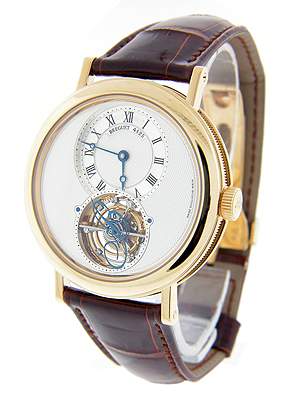Tourbillon Watches
This curious invention of the Tourbillon in 1795, belongs to Abraham-Louis Breguet, who was known as the watchmaker of all Kings and the King of the watchmakers.
Even in its most conventional version, Tourbillon watches are very hard to manufacture and there are many differences between a hand-crafted cage, and a certain industrially fabricated creations.
A Tourbillon equilizes the effects of gravity by mounting the escapement and balance wheel in a rotating cage in order to negate the effect of gravity when the timepiece is rotated. This mechanism usually shows off on the face of the watch.
To define better a Tourbillon, we can say that it is a mechanical device consisting of a rotating cage carrying at least the balance and the escapement. The cage is rotated by the gear-train. It turns co-axially to a toothed crown placed on to the plate which serves to maintain the oscillator by means of a pinion carried by the cage.
The first Tourbillon mechanism was made by Breguet for Napoleon in one of his carriage clocks weighing almost 200 pounds.
In 2003 Thomas Prescher developed the Double Axis Tourbillon, for the Thomas Prescher Haute Horlogerie, powered by a special constant force mechanism called Remontoire. This mechanism equalizes the different forces caused by wound and unwound mainspring, friction, and gravitation effects.
Later in 2004 Thomas Prescher presented the Triple Axis Tourbillon, which comes with a constant force in the carriage in a wristwatch called Remontoire as in the Double Axis Tourbillon. In this high-end complication is that the tourbillon is turning around 3 axis. The first and the second axis both complete one rotation every minute and the third axis turning once every hour.
The Tourbillon is one of the most valued features of collectors’ watches and premium timepieces.

Breguet Tourbillon



 Instagram
Instagram Twitter
Twitter Facebook
Facebook

Leave a Reply